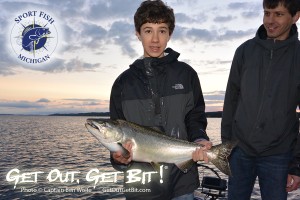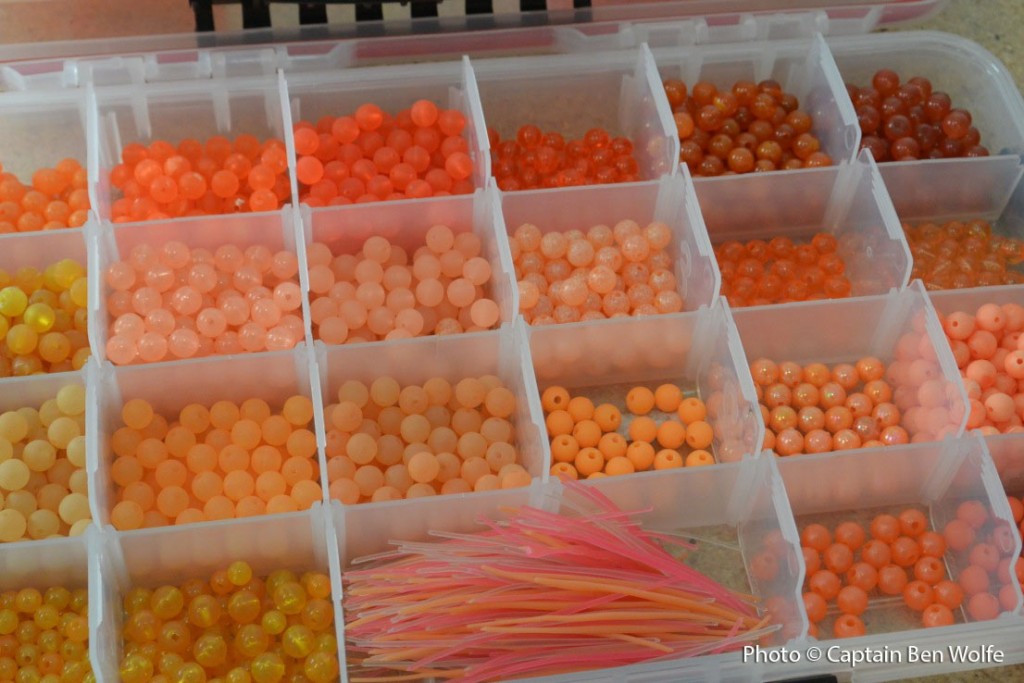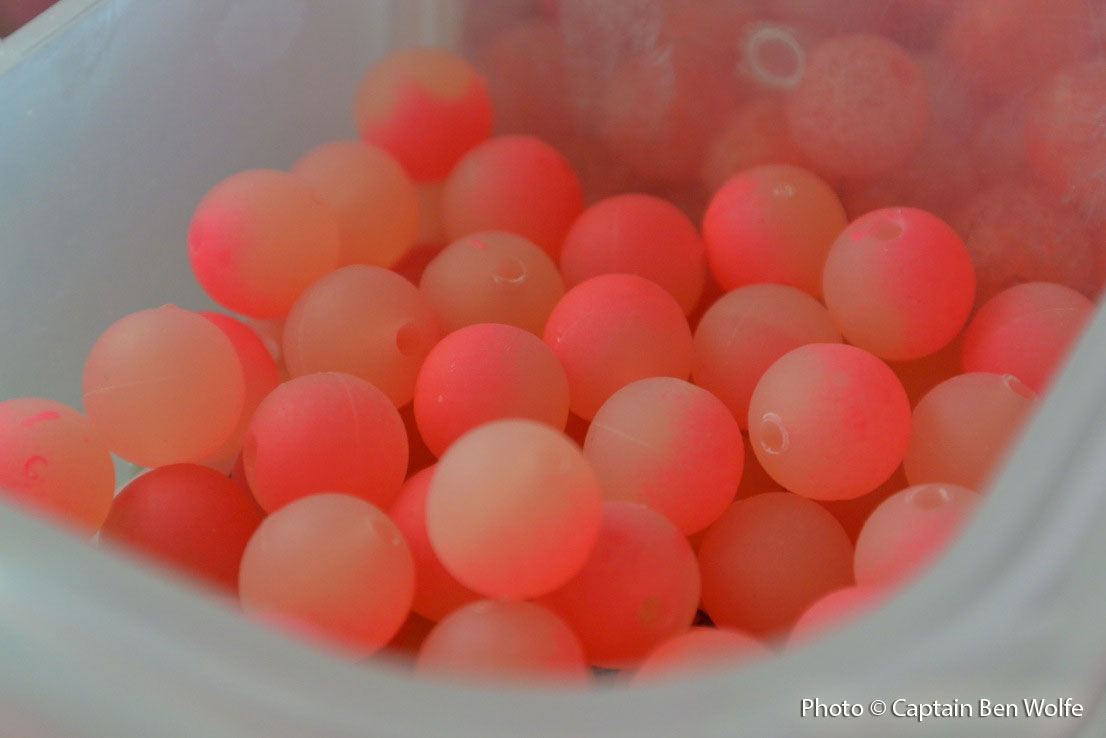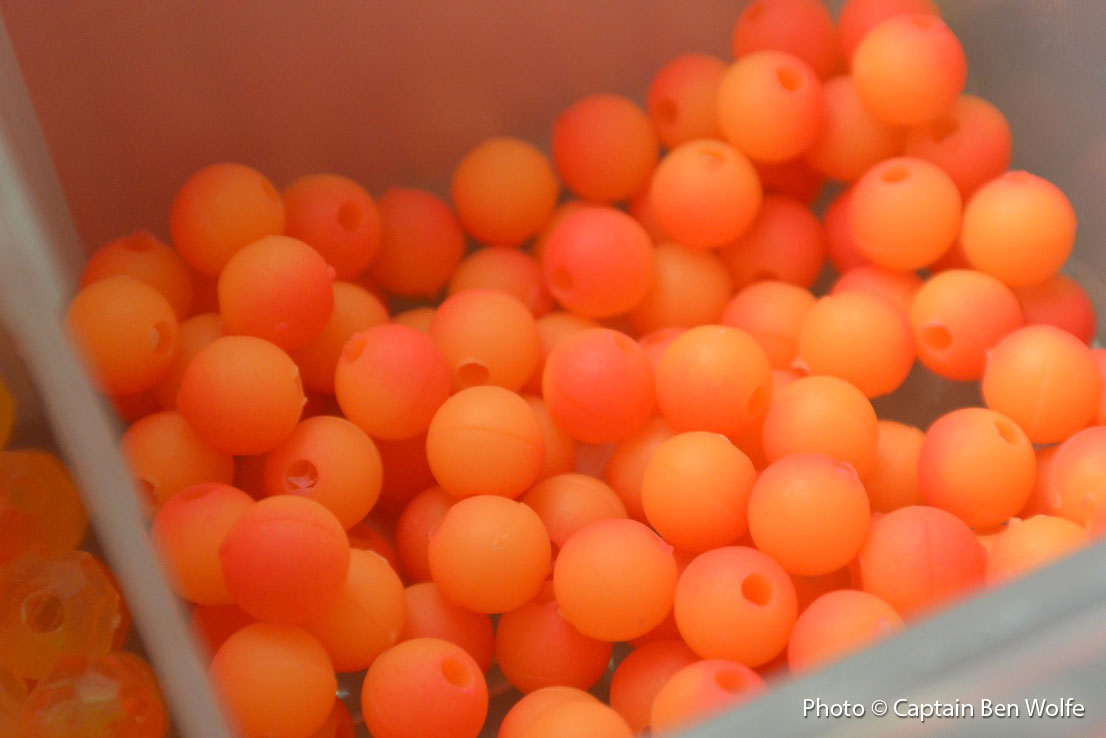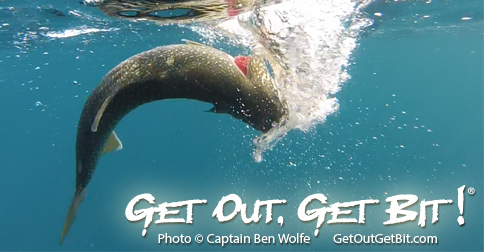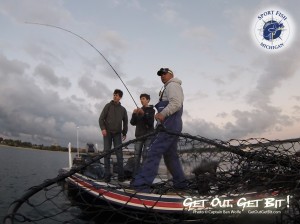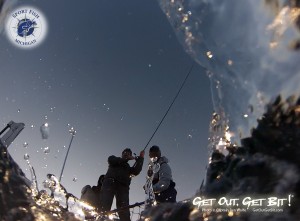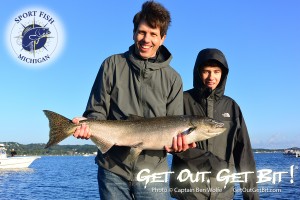Get Out, Get Bit! With Sport Fish Michigan. Your source for the top fishing guides in Michigan.
Tag Archives: salmon
2014 Year in Review and a Look Ahead to 2015 Part 2
Part 2: The Future
Looking ahead to the 2015 season, we are encouraged by the opportunities that lie ahead for all of our guide services. We have a lot of goals, many things that are inspiring us to push further ahead, and things we want to improve upon.
Traverse City Bass Guide Service will be guiding again this year on Grand Traverse Bays as well as many of the potent inland lakes around the Traverse City area in northern Michigan. Bassmaster Magazine ranked the Bays #9 in their rankings of the top 100 Best Bass Fisheries in the World. That’s pretty exciting, especially when 4 out of the 5 lakes mentioned in the rankings were all in northern Michigan! Partnering with a couple of bass guides within the Sport Fish Michigan network of the Michigan’s top Captains and Guides, we can offer trips on each body of water mentioned in the Bassmaster Magazine rankings. Who knows where these lakes will be ranked in 2015 but the future looks incredible, and we are excited for spring to be here so that we can get back out, chasing after smallmouth and largemouth bass. With changes to the Michigan fishing regulations on the horizon, we may even see a change which will allow us to be able to target bass year-round in a catch & release manner. Under the proposed Michigan DNR changes, the open season would remain the same, but we would now be able to target bass all year long when practicing catch and immediate release.
Wolfe Outfitters will be entering its second full season as the only permitted outfitter allowed to fish inside the Sleeping Bear Dunes National Lakeshore. What makes this truly exciting is that we are poised to be able to target the outstanding steelhead and brown trout fishery at the mouth of the Platte River in the spring. Steelhead and brown trout can be caught with a variety of techniques including casting, fly fishing, and trolling. Casting minnow baits, like jerkbaits, is a great way to enjoy these feisty fish, and with the gin clear water that Platte Bay has, being able to watch these fish fight and chase offerings is nothing short of awesome. For fly anglers, stripping streamers is every streamer angler’s dream come true, as both browns and steelhead respond well to this technique. Trolling andsa jigging can also pay off handsomely out on Platte Bay.
The salmon fishery on Platte Bay is something to behold, and we are hopeful for a great run in 2015. Coho were first stocked in the Platte River by the DNR back in the mid 1960’s, and created the world-class coho fishery that we enjoy today. The bulk of our techniques employ casting and jigging techniques for these awesome fish. We had a lot of customers out on Platte Bay in the Sleeping Bear Dunes National Lakeshore this past fall, and every single person was blown away by not only the incredible fishery on the Bay, but also the scenery. After all, Sleeping Bear Dunes wasn’t named the most Beautiful Places in America by a Good Morning America poll for nothing!
Jigging trips went extremely well last year, and we are looking forward to building on that momentum. With the incredible lake trout fishery that the northern Michigan area has to offer, jigging is a truly addictive way to target these fish. With the light bass tackle that we use, anglers get to feel every bump and bite from these aggressive biters, and the fight is heaps more than many anglers have experienced in the past with other techniques.
River trips will continue to be a major focus of Wolfe Outfitters and its Guides in 2015, and we are excited about the prospects of not only lots of salmon and steelhead trips, but also about the outstanding smallmouth bass fishery on the Manistee River as well as its trout fishery. The portion of the Manistee River just below Tippy Dam is absolutely spectacular for trout fishing, and this year’s fish will be pushing a very healthy 20 inches by the end of the summer, with many fish well over that mark.
We have both Michigan State and Federal permits, including the highly coveted permits for the Manistee National Forest. This gives us access to fish the entirety of the Manistee River, utilizing the Federal launches that many other guide services aren’t able to take advantage of with their customers. While the salmon and steelhead runs were below average, and definitely below what we have become accustomed to, we are excited about the spring steelhead run. With low numbers of steelhead running all of the northern Michigan rivers in the fall, this sets up well for a stellar run in the spring. We are looking forward to targeting these chrome beauties when they enter the area’s rivers.
Sport Fish Michigan has grown each year, and we are hopeful that 2015 will be no exception! We are thrilled to have each and every Captain and Guide that we have, and each brings something special to our customers’ trips. From fly fishing to bass fishing, trolling the big lake to river trips, and even ice fishing, we are working hard to offer everything an angler might want around the state. We are once again sponsoring the Hook n’ Look television show on the Outdoor Channel in 2015, and are excited about the national exposure from this popular show.
In addition to the Hook n’ Look show, we hope to be able to produce our own videos on a variety of fisheries utilizing our Sport Fish Michigan Captains and Guides. We plan on filming walleye fishing in the spring on the Detroit River. The Detroit River is truly spectacular for walleye fishing in the spring, when these tasty fish run into the river to spawn. We also plan on filming bass fishing with several of our Captains on Lake St. Clair, taking advantage of this world-class bass fishery.
Further north, lies the Muskegon River, the Manistee River, Betsie River, and Platte River. All boast stellar steelhead runs, and it is our goal to film some steelhead clips on these rivers fishing with our Guides both with conventional tackle as well as on fly.
Atlantic salmon are on the list of species we would like to highlight as well, and Torch Lake just north of Traverse City is host to an impressive population of Atlantics. The super clear water that Torch Lake is known for will make this a treat, as these are a beautiful fish.
We are also tremendously excited to be the largest ice fishing operation in Michigan, and are hoping to build upon the successes of last year. Ice fishing is a very popular aspect of fishing, and early indications are that we will be busier than ever. This year, we are planning an inaugural on-ice seminar clinic that will span 2 days. We will discuss rigging options, how-to demonstrations, and technique options accompanied by hot catered lunches right on the ice. All of the necessary tackle and gear will be provided for the seminar, as well as transportation on and off of the ice.
In all, the future is bright for everything that we have to offer. With continued hard work and dedication by all of our Captains and Guides, we will continue to strive to create lasting memories and outstanding experiences for each and every one of our customers.
2014 Year in Review and a Look Ahead to 2015
Part 1: The Past
As 2014 draws to a close and we look forward to the New Year, I would like to share a few thoughts about this year, as well as express my extreme gratitude to our valued customers and friends for a truly wonderful year. All of our guide services were blessed with another very busy year guiding some really wonderful customers. We loved fishing with our old customers, and we relished the opportunity to fish with new customers as well.
Sport Fish Michigan’s Captains and Guides enjoyed fishing with their customers, as always. Traverse City Bass Guide Service had another incredibly busy year. Bassmaster Magazine ranked Grand Traverse Bays in the top 10 for best bass fisheries in the world. This brought additional attention to something many of us already knew—just how special this fishery really is.
Wolfe Outfitters and Manistee River Salmon Guide Service were both as busy as ever. With multiple Guides working, we enjoyed lots of guide trips fishing for everything from salmon and steelhead to brown trout, lake trout, smallmouth bass, and even panfish. Wolfe Outfitters became the only permitted guide service allowed to fish inside the Sleeping Bear Dunes National Lakeshore. This opened up the door to giving customers access to world-class fishing for coho salmon near the Platte River—the birthplace of the entire Great Lakes multi-billion dollar salmon fishery.
We received quite a bit of great press as well, which is always appreciated. Traverse! Northern Michigan’s Magazine was nice enough to include our ice fishing in its newsletters, as well as sending out a writer and photographer to do an upcoming feature story on wintertime river fishing. Conde Nast Traveler released a terrific mention and photo of our guided ice fishing services in their story about the top things to do around the country in ski towns other than skiing! What a huge honor to be mentioned in this long-standing and very popular travel magazine. The Traverse City Convention & Visitors Bureau covered our ice fishing in both a newsletter and web story. Mountain Life Magazine, published by Crystal Mountain, also did a story about us in a feature article. We are working with a couple of writers out of Chicahgo for upcoming stories. The Angler Magazine did a feature article on us, showcasing the outstanding vertical jigging opportunities for lake trout on the Grand Traverse Bays.
9 & 10 News interviewed me for a story about bass fishing the Grand Traverse area, and Sport Fish Michigan sponsored the very popular national television show, Hook n’ Look. Hook n’ Look airs on the Outdoor Channel, and has the kind of loyal following any fishing show would want. In addition to the many small video clips we filmed ourselves, we also filmed a couple of different shows with a new fishing show that will air in January called iFishigan. This new show will air on the World Fishing Network.
The fishing was outstanding in many ways, and odd in others. With the extremely cold winter we experienced, the spring thaw was delayed by almost a month. Downstate, the walleye fishing was outstanding on the Detroit River. Surprisingly, the cold waters didn’t cool the bite at all. Lots of walleyes, many of them impressive in size, were caught by Sport Fish Michigan’s Captains and Guides. The walleye fishery on the Detroit River is stunning, and anglers vertical jigging with our Guides had great catches most days. Bass fishing on Lake St. Clair was incredible, as usual. The winter, although brutal, didn’t seem to faze the fishing much, and the bite turned hot almost right out of the gate at the start of the season. Not surprisingly, Lake St. Clair’s incredible fishery kept its reputation intact, despite falling a bit in the Bassmaster Magazine top 100 best bass fisheries in the world.
In northern Michigan, the cold took its toll a bit more, and it took longer to warm up. River levels were very high from the huge amount of snow that fell, and the spring steelhead run lasted much longer than normal. We were even fishing steelhead in late May on the Manistee and the Platte rivers! The walleye fishing on the rivers like the Manistee and Muskegon rivers was also very good. The opener to the season played right into the hands of anglers due to the cold water making for a later run. Normally, the run is over on the rivers before the season opener, but this year we were able to get on the walleyes in great fashion.
Wolfe Outfitters guide trips not only were able to target trout and steelhead, they were able to keep many of the walleyes that were caught after the season opener. Throughout the season, the trout fishing was incredible and, even now, it continues to be stellar. The salmon and steelhead runs are something that many are talking about. Not only has the DNR decreased the amount of king salmon stocked into Lake Michigan, the conditions were such that we did not have a good fall run. Guide trips went well despite this, and customers still were able to have a great experience, even if the fishing was slower than customary.
Bass fishing was stellar, as usual, but we weren’t able to enjoy the early spring bite as much as normal. Traverse City Bass had many thrilled customers despite some chilly water temps early in the season. With an unseasonably cool summer, many of the patterns ran late in the season, including the spawn. We even had spawning smallmouth in August! I’m not sure what that will mean for the success rate of the bass fry, but hopefully it won’t be too bad. We were able to showcase the incredible smallmouth fishery that we have to many new customers this year, and we enjoyed fishing with our repeats as well. It is such a treat to fish with customers every season—not only are they excellent customers, they also become friends.
Sport Fish Michigan’s endeavors this past year included offering vertical jigging trips to customers using Wolfe Outfitters Guides and Sport Fish Michigan Captains. The jigging this year was absolutely incredible, and we were very fortunate to have the beautiful lake trout to play with this year. On light bass tackle, they put up an incredible fight, and this was something that all of our anglers thoroughly enjoyed. Especially when they can feel the bite, and get to set the hook as well as fight the fish the entire way in.
On a personal note, I was nominated along with many other outstanding charter Captains, for the Best Charter Boat Captain in the annual Traverse Magazine Red Hot Best public poll. Traverse Magazine conducts this popular poll each year for the “Best Of” in Northern Michigan, and I was honored to be among the top 3 vote-getters in this inaugural category. Given the number of other nominees and some of the longevity of many of these fantastic Captains, it was very humbling to be voted among the top 3. In fact, to make things even sweeter, I was the only Captain in this category who actually offered fishing charters. The other two operate sunset cruises, capable of servicing many customers each time out. A huge THANK YOU to each and every person that voted to help put me on top!
Our new boat that was trucked out from Washington State this past winter, and outfitted specifically to highlight the jigging technique. Our customers loved it, and it proved to be invaluable. It was a joy to be able to offer trips out of this boat, and its worth proved itself on the big waters of Lake Michigan, Grand Traverse Bays, as well as the L. Michigan waters of the Sleeping Bear Dunes National Lakeshore. It also functioned extremely well as a river boat, and its design proved priceless. The Evinrude E-Tec on the back of this 20-foot beauty is outfitted with a jet drive, and is able to handle both the bigger bodies of water as well as allowing our new boat to run on plane in water as shallow as 4 inches! Outfitted with a kicker motor, an electric anchor winch, Minn Kota i-Pilot link on the Terrova electric motor, and Humminbird Onix electronics, this is the ultimate fishing machine. Many of our Wolfe Outfitters and Sport Fish Michigan customers got to enjoy this new boat, and I think they would agree that it truly is an awesome boat to from which to fish.
The Case for Fishing Beads
The Background
Beads, the colored orbs of the fishing world meant to resemble fish eggs, should be a clear choice for anglers targeting river systems for salmon, steelhead, and trout. Beads have been around for years, but are gaining popularity every year. New bead companies are now pushing the boundaries, offering new color choices and sizes. Increasing options like this gives anglers even more options to match bead colors with river conditions, and egg colors that can vary by species and location.
Beads by themselves are simple. Made of plastic, in sizes ranging from 4mm to 12mm, with seemingly endless colors. Some beads are hard plastic, and some are soft plastic like rubber bass worms. Hard beads are slow to sink, making them perfect in river current-bouncing along the bottom and swirling, just as real natural eggs do. In contrast, the soft plastic beads float in the water. This makes them a great option to bounce along the bottom, resisting snags. The soft texture of these beads feel natural to a fish when they pick up the bead, causing them to hold on longer and giving anglers more opportunity to set the hook.
The beauty of beads is their versatility. They can be fished by fly anglers or traditional gear anglers alike. They can be bounced along the bottom in a bottom-bouncing or side drifting technique, they can be used on a chuck and duck presentation, or they can be fished under a float. Meant to resemble a single egg, beads are typically pegged onto the line a couple of inches above a hook. Presented in this manner, beads can be fished by themselves or, more commonly, on a double tandem rig with two beads, or a bead and fly combo.
The Controversy
Despite the proven effective fish-catching power of beads, there are those that don’t care for them. Some believe that fishing beads is not as effective as fishing bait-meaning cured or raw salmon eggs. Others believe that fishing beads is unethical, as the bead is traditionally pegged above the hook. Legally speaking, there are no restrictions on fishing beads-they are perfectly legal to fish, even when pegged onto the line above the hook. The main argument against the use of pegged beads above a hook seems to be that the bead is not attached to the hook, making it a snagging technique. Again, there is no legal restriction against this rigging presentation, and I would argue that there are other commonly used techniques that are just as, if not more, prone to snagging fish as the use of a pegged bead. Most of the bead fishing done by Sport Fish Michigan and Wolfe Outfitters guides uses beads fished under a float. I believe that it is difficult to snag a fish when fished under a float.
They Flat Out Work
In fishing, there is a time and a place for every presentation. Bait has a time and a place, and so do beads. There have been countless times that beads have out-fished bait. And the simplicity of beads means anglers don’t have to mess with getting and curing salmon eggs and tying them into spawn sacks. When fish are keying-in on single eggs, beads are incredibly tough to beat. Additionally, strikes can be enticed by applying different scents to beads. Alternately, when salmon or steelhead are keying in on larger presentations, spawn sacks or chunks of skein can be more effective.
Beads offer versatility in rigging. Color and sizes give anglers a presentation that can appeal to a variety of species all at the same time. Salmon, steelhead, rainbow trout, brown trout, lake trout, and brook trout all eat beads incredibly well. In addition, we have caught walleyes, bass, bluegills, and even hooked up with sturgeon on bead presentations.
In Conclusion
Despite the limited controversy over bead fishing, their use continues to grow in popularity and effectiveness. I, for one, will continue to use beads, as they have proven themselves over and over on guide trips here in northern Michigan. Chasing trout, steelhead, and salmon, beads have a place in my guide box. There are many great bead companies, and the three that I use most are Trout Beads, Great Lakes Bead Company, and Steelhead Beads from the west coast. All offer something different, and all beads are not created equal. A bead isn’t just a bead, and it pays to experiment with color combinations and color differences. The way light illuminates a bead color can vary drastically from river to river, and fish may prefer one color or size to another in different systems. If beads aren’t in your bag of tricks, give them a try. You may be surprised by their simple effectiveness, and I’m sure you’ll agree with me and my Sport Fish Michigan and Wolfe Outfitter guides that beads may very well become a favorite go-to when chasing salmon, steelhead, and trout.
Vertical Jigging Basics for Salmon, Lake Trout, and Whitefish
Vertical jigging for salmon, lake trout, and whitefish can be as simple, or as complicated, as we want to make it as anglers. There are some very definite things that I think set apart those anglers which generally do well day-in and day-out overall, and those that hope to get lucky out on the water. Certainly, fish are fish, and every day is a learning experience that can be humbling.
Here are a few basic things that I feel are critical to understand for increased success when out on the water using a technique like vertical jigging.
Equipment:
Rods—Rods used for vertical jigging traditionally fall into 2 categories—small, short ice fishing style rods, or longer bass fishing style rods. There are pros and cons to each.
Personally, I use medium or medium-heavy bass rods for my vertical jigging needs. I like the additional length of a 6 -7 foot bass rod because I can move a lot of line on a hook set, while I still have the ability of making jigging motions as small or as large as I like. Some days, a jigging motion needs to be very small, but many days, the preferred jigging motion is larger, meant to really trigger an aggressive response from salmon and lake trout. I also feel that a longer rod is better able to cushion the hard tugs and pulls of lake trout and salmon. This way, the rod can fight the fish, not just the line.
Stout ice fishing rods are small and mighty, and really lend themselves well to a smaller jigging motion, as sometimes is necessary to trigger finicky fish. Whitefish tend to like much less action, and these rods make it hard for anglers to over-work a jig. While this is a plus, the big negative side to this style of rod is that an angler can move much less line on a hook set when a fish eats a jig as it comes up in the water column. I have missed many more fish with shorter ice rods than I have with longer bass rods, unless the fish hook themselves. There is a large following of dedicated jiggers that swear by this style of rod, but my preference lies with the longer bass style rod.
Reels—Fishing reels are kind of a no-brainer. Baitcasting reels paired with a baitcasting rod are my personal preference for jigging, but spinning rods also have a time and place. When paired with the proper rod, either spinning or baitcasting is a great option. I like to use the smaller bass size reels, as they get less tiring to use over a long day of jigging. Line capacity is often misunderstood, as most bass reels can easily handle 100-150 yards of line. That’s 300-450 feet of line! Considering that most jigging situations are in 150 feet of depth or less, there is more than double the capacity needed to jig and fight fish.
Lines—I always prefer braided line for jigging, tied to a fluorocarbon leader of about 6 feet or so. I typically use 15 pound Power Pro line which, over the years, has proven itself time and time again. Braided line fishes well even when twisted, unlike straight monofilament or fluorocarbon. Braided lines also offer a huge advantage in sensitivity—something that is needed to help detect the bottom when it’s windy or wavy out. Braided line also helps to get a good hookset when fishing in depths over 30 feet. With almost zero stretch, braid gets the hook penetrated almost immediately when the hook is set, as opposed to monofilament which has almost a 40% stretch factor. With a limber bass rod, braided lines won’t pull out of a fish’s mouth as many would believe, because the rod cushions the line. Fluorocarbon leaders are a must in our clear water, as fish can be line shy, even at depths of 100 or more feet. Fluorocarbon has the same refractive index as water, and is nearly invisible underwater. I prefer a 6 foot section tied directly to my braided line. Another added bonus of fluorocarbon is that it is much more sensitive and has much less stretch than monofilament. With braid as my main line, and a fluorocarbon leader, I am now ready to jig.
Jigs:
Jigs used for vertical jigging are as varied, and they all have their time and place. While each may trigger bites on any given day, there are a few basic things to understand within the jig category. How a jig falls, and the action that it gives when jigged, can have everything to do with how well a day can go on the water. Having a variety of jigs on the boat, and an open mind about experimenting, can really help to boat more fish. Also equally important can be jig weight. How quickly a jig falls can also play a large role in triggering bites, or going unnoticed and ignored. I prefer jigs anywhere from 1-3 ounces for lake trout and salmon. When vertical jigging a species like burbot or whitefish, smaller jigs can be the ticket. For these fish, I prefer jigs in the ½-1 ounce range.
I almost always use either a snap swivel or a line snap to attach my jigs. I nearly never tie directly to the jig when I am using treble hooks. However, when using jigs that have a single free-swinging assist-style hook, I will tie directly to the split ring, as these baits were intended.
Flutter / Butterfly style—this is a style of jig that is most commonly used in saltwater. These style jigs usually have a horizontal flutter fall, but within this category, there are differences in the upward motion. Some pull straight upwards when jigged. Others have a side-to-side flutter when pulled up in the water column – Jonah Jigs is a prime example of this style of jig, as are Shimano Butterfly jigs.
Corkscrew fall style—these style jigs are also often used in saltwater, and have a spiral action as they fall. Different species of fish seem to like these falls better. Lake trout and salmon often prefer a flutter style of fall in the water, but there are days when a corkscrew fall is the only way to trigger bites. The Shimano Coltsniper is an example of this style of jig. Swedish Pimples fall into both the flutter and corkscrew style categories, since jigging motion can create both actions.
Shad style—These style of jigs are more football shaped, more closely mimicking a shad body. They have action on the fall as well as a tight vibration on the up-jig motion. These baits work wonders when there is a big shad or alewife population that fish feed on, and here in the Great Lakes, alewives are a staple for salmon and lake trout.
S-shape style—This category of jigs has a slight bend in them, resembling a softly-curved letter "S". The bend in these jigs promotes a lot of water displacement both on the jigging motion up, and the fall of the jig. This not only produces an erratic action, it also has a lot of vibration, which can really help to bring fish in from a distance. BBM and Elk Rapids jigs are options for Great Lakes anglers. Jonah Jigs and PLine jigs can be bent to create an "S" shape, altering both the fall rate and action.
Do nothing style jigs—this is a style of jig that is most commonly used when the water is very cold. BBM makes a jig called a sand kicker. This jig does nothing, but jig up and down, with no side to side or fluttering action. Lake trout, whitefish, and burbot love these jigs when the water is cold, and they are often used by ice fishing anglers. Here, it is critical to tie the fluorocarbon directly to the jig without the use of a snap or swivel.
Bites:
Bites from salmon and lake trout can be varied, despite an aggressive nature overall. Understanding the different types of bites can help to land several more fish over the course of a day on the water.
On the fall/drop—Lake trout and salmon like to hit on the drop, as the jig is still falling through the water column. Bites on the fall can, themselves, be split into two distinct categories. First are the bites that occur as the rod is moving downward, following the jig on the fall. The bite occurs, and the rod is jerked down aggressively. An immediate hook set upwards is the way stick these bites.
The second way salmon and trout bite requires attention being paid by the angler. It’s not uncommon for a laker or a salmon to swim up in the water column to grab the jig, putting slack into the line. Anglers should be aware of how far they are lifting and dropping their jig, and should the jig not fall as far as it should, this is a sure sign that a fish has it, and a big hookset while reeling like crazy can often times stick these aggressive biters. A common telltale is a pile of line on the surface instead of a semi-taught line as the jig falls. This happens multiple times throughout most guide days, and the anglers that notice this are quite often rewarded with a fish that may otherwise have gotten away – the jig spat out quickly.
On the uplift—it’s not uncommon for bites to occur on the uplift of a jigging stroke. An angler is lifting the rod, and all of a sudden, there’s slack in the line when the weight of the jig should be keeping the line tight. A quick hook set is the only way to stick these fish, and a longer bass style fishing rod is critical here, due to the added ability to move line quickly.
Jigging away—When using good sonar units to mark fish, it is common to see our jigs fall towards fish. One way to trigger a reaction strike from lake trout and salmon is to mimic a fleeing baitfish. In order to get this kind of response, a jig can be jigged up and away from fish to trigger bites. A quick jig, reel several cranks, another quick jig, followed by more cranks of the reel is the most common method used to trigger these powerful reaction strikes. Another alternative form to get fish to chase a jig, is to just reel quickly away from fish that are known to be in the area. It’s fairly common to hook a fish reeling quickly when another angler on the boat has a fish on, and the angler is simply reeling up to get their line out of the way. On a recent trip, I had a fish chase my jig all the way to the boat from 87 feet of water, trying to eat the jig even as it came out of the water! Had I known I had a chaser, I would have slowed down just a smidge, to give the fish time to eat, but since I was focused on getting the net for my customer, I had no idea that I had an aggressive lake trout chasing my jig.
Boat control:
Boat control is critical in the sense that we need to understand how we are going to fish. Do we need the boat to hold in a specific spot because we want to fish a particular depth or contour break line, or do we intend to drift a flat covering lots of water looking for active fish?. To further discuss boat control means to break down into two categories how we intend to present our jigs.
For salmon and lake trout in particular, jigs should often be close to the bottom, if not occasionally bumping the bottom. If we intend to drift with the wind, we can use a motor, whether it is an electric trolling motor or a kicker motor, to hold the boat in a particular depth as we drift along. Using a drift sock can greatly slow the rate of drift, very often enabling us to feel the bottom. Drifting too quickly pulls the jigs away from the bottom, and more and more line must be let out to continually stay in contact with where the bottom is, and where the fish mostly hold. For this technique, boat speed is the crucial aspect that will help success rates.
For vertical jigging, the more vertical our presentation, the better our success when fishing a specific depth or contour break line. To hold in a particular spot, depth, or contour, I prefer the use of an electric trolling motor to accomplish the task, but a kicker motor put in and out of gear is a perfectly acceptable alternative. While holding on a spot, it is also possible to cast jigs out away from the boat, let them fall and jig them back with great results.
How to rig for vertical jigging lake trout on Grand Traverse Bays using Jonah Jigs
Jonah Jigs creator, Larry, shows Capt. Ben Wolfe of Sport Fish Michigan how he rigs to fish for lake trout, whitefish, and salmon on Grand Traverse Bays near Traverse City using the vertical jigging technique for deep water. Vertical jigging is a hands-on technique using jigging spoons that is extremely effective at targeting fish holding in deep water.
Reeling in a Huge Salmon on the Manistee River
A Wolfe Outfitters fishing customer catches a giant salmon while casting crankbaits on the Big Manistee River in northern Michigan.
Thank You
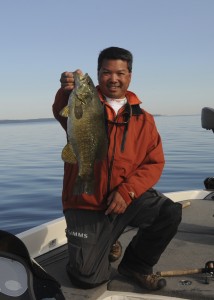 Creating Sport Fish Michigan has been a tremendously rewarding journey, and to see it come together has been awesome and humbling. Sport Fish Michigan started out as a way to attract attention from search engines for my Traverse City Bass Guide Service and Manistee River Salmon Guide Service businesses. It has since grown to be so much more – a network of the top Charter Captains and Guides in the state, and I could not be more proud.
Creating Sport Fish Michigan has been a tremendously rewarding journey, and to see it come together has been awesome and humbling. Sport Fish Michigan started out as a way to attract attention from search engines for my Traverse City Bass Guide Service and Manistee River Salmon Guide Service businesses. It has since grown to be so much more – a network of the top Charter Captains and Guides in the state, and I could not be more proud.
Sport Fish Michigan, or SFM as I call it, now features some of the top Guides and charters around Michigan, all of whom I know personally. As SFM began to grow out of its humble web beginnings, I added friends of mine that were Captains and Guides, with the idea that we would share referrals to each other. We’re still small, but strong. And we are growing!
SFM features Guides and Captains that specialize in almost every species that anglers want to target here in Michigan. King salmon, coho salmon, atlantic salmon, smallmouth bass, largemouth bass, steelhead trout, brown trout, brook trout, rainbow trout, walleye, lake trout, perch, muskies, pike, panfish, and even some less commonly targeted species like carp, gar, catfish, and burbot!
All of these species thrill anglers of all ages! Not only do our Captains and Guides know how to target an angler’s species of choice, we have built a network that can facilitate an angler catching their preferred species using the techniques that they prefer. Casting artificial baits, vertical jigging, fly fishing, trolling, or casting live bait—SFM’s Captains and Guides have the knowledge and the boats to accommodate just about anything a customer could want.
Michigan is blessed with an incredible number of lakes, rivers, and streams, and most of these are clear bodies of water that were glacially formed. With such a variety of fish species to choose from, and with such a vast choice of waters to fish in, it can be hard to narrow down which guide to choose. All guides look good on a web site full of pictures. My intent with SFM was to create a top-notch referral service that would take the guesswork out of who to book on certain bodies of water.
Sport Fish Michigan is now even a sponsor of the very popular national television show, Hook N’ Look, hosted by renowned bass professional and retired tournament angler, Kim Stricker. Sport Fish Michigan is even sponsoring a local Traverse City high school bass team, encouraging the sport of bass fishing and the youths that enjoy fishing.
Traverse, Northern Michigan’s Magazine had their annual Red Hot Best poll a few months back, and this year saw a couple of new categories, including the best Charter Boat Captain. The list of nominees and write-in candidates grew to an impressive length, as northern Michigan has world-class fisheries. There are lots of area guides and charters to choose from. I was lucky enough to be one of those nominated, and it was exciting to learn a month or so ago that I was one of the 3 top voted for in this new category. With the June issue on newsstands, it is an absolute thrill to finally let the cat out of the bag! Of the top 3 spots, I am actually the only Charter Boat Captain that offers fishing trips! That was a shock to me, considering how many well-established fishing charters there are in northern Michigan.
Hats off to Chien Nowland of the Nauti-Cat for garnering the top spot in this category, and to Chris West of the Ugly Anne up in Mackinaw City as well. Chien and Chris are both terrific operators of water cruises, taking customers sight seeing and sunset cruising in style. It is, without doubt, a tremendous honor and source of pride to be in the top 3, and especially to be the only fishing charter Captain.
I would like to sincerely thank all of those who voted in the Red Hot Best poll. Thank you to each and every one of my customers who have fished with me or one of my esteemed Sport Fish Michigan Captains and guides over the years, making each trip special and memorable. Many photos from our trips grace the web sites that make up Sport Fish Michigan. I would also like to thank my other Sport Fish Michigan Captains and Guides, and those that have helped us along the way. This honor isn’t just for me—it’s for all of us. We did it together. Thank you for all of your hard work, dedication, and for working together to make something great!
Casting for King Salmon on the Big Manistee with Wolfe Outfitters
Wolfe Outfitters customer Mark, with his father, Gary, battling a king salmon on the Big Manistee River. This fish was caught while casting crank baits, which is a productive and addictive technique for early salmon in Michigan rivers.
No coffee needed!
It’s a pleasure fishing with customers who book with Traverse City Bass Guide Service. I enjoy meeting new people and sharing in their special day on the water as we fish for smallmouth bass on the beautiful world-class waters of Grand Traverse Bays. Occasionally, opportunities that don’t involve bass fishing present themselves that I love to pass along to my customers.
Such an opportunity presented itself several days ago when there was a hard north wind for a couple of days in northern Michigan. Late summer typically means that salmon will make their way close to river mouths where they will run upstream to spawn. A hard north wind will often stack the salmon up in thick numbers, making them easy for boats not outfitted for trolling, such as a bass boat, to use techniques other than trolling to cast to, and catch, these awesomely powerful fish.
In Traverse City, the Boardman River empties into West Bay. Adjacent to this river mouth is deep water, known as “the hole.” Salmon congregate in large numbers in the hole, bringing with them a set of opportunities for catching them that doesn’t have to mean trolling from a large charter boat. While trolling this is a terrific technique enjoyed by many, others prefer a more hands-on approach. I am definitely one of those-enjoying the challenge and adrenaline rush of catching salmon with rod and reel in-hand.
A few days prior to my bass trip with a couple of new customers, when I typically contact my customers, I knew that there would be an opportunity to vertical jig for king salmon in “the hole.” My customer, Michael, seeking a thrill for himself and for his son, readily agreed that targeting salmon would be an interesting alternative to bass fishing. We agreed to meet in the pre-dawn hours, getting out early trying to hopefully take advantage of the first light bite.
Early morning fishing requires caffeine if you’re me. In fact, for me, every day requires coffee-especially if you own a coffee company, which I do. Deep Blue Coffee Company supplies coffee to Traverse City Bass for its customers to enjoy during their trip, often eliminating a customer’s suffering through hotel coffee. They get to show up at the boat ramp, and I’ll have a great cup of coffee waiting for them.
This day, I somehow forgot the coffee carafe, and sent my customer a text that I had dropped the ball and forgotten the coffee. “No worries,” he said, “I don’t drink that much coffee anyway.” Nevertheless, I felt terrible about my oversight.
We launched the boat in the pre-dawn darkness, and headed down towards the hole in hopes of being able to hook up with some salmon by jigging Jonah Jigs, which were designed specifically for vertical jigging salmon. Armed with my G.Loomis jigging rods, we were rigged and ready for business! After showing my customer and his 13-year-old son the proper techniques for jigging, we began our day by looking for schools of salmon on my sonar. Bingo, there they were!!! “OK, drop guys!” By dropping our Jonah Jigs to the bottom and reeling up to the depth that the salmon were holding in I knew that we were in a good position to hopefully get bit in short order.
It wasn’t long before I felt the telltale aggressive jolt from a salmon, but didn’t hook up. Shortly after my bite, Michael also got a bite, stopping his heart for a moment. “You weren’t kidding when you said that this was an aggressive bite!” Now we were on to something. No sooner had he finished sharing his experience about the sensation of the bite, he was hooked up, with drag peeling off of my Shimano reel. “Holy **Bleep**!” he shouted, “NO COFFEE NEEDED!!! THIS IS AWESOME!” After a 5-minute battle full of drag pulling and powerful thrashing on the surface, our king salmon was in the net, coming aboard for some photos. Perfectly hooked right in the jaw.
I’m pleased to say that we were able to boat 4 salmon, out of the 7 that we hooked up with. We had numerous other bites, including a dandy lake trout that Michael’s son, Justin landed. The entire time, Michael kept saying how exciting it was to catch a salmon with a technique that allowed him to feel the bite and fight the fish all on his own. It was a fantastic morning of fishing, and the added benefit was that they were able to take their catch home, something that we don’t allow when we bass fish. As a guide, it’s gratifying knowing that my customers had a day that far exceeded their expectations. And to be able to take advantage of a unique set of opportunities made it all that much more special. We can’t always jig for salmon, but when the circumstances present themselves…. Good things can happen!
